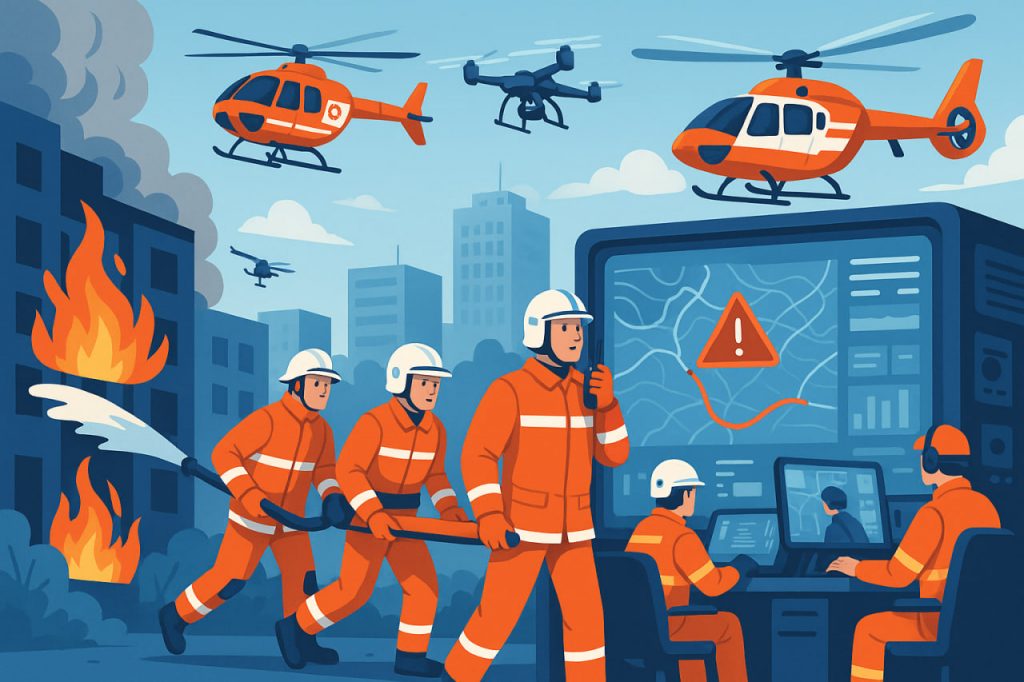In today’s rapidly changing world, disasters — both natural and man-made — pose growing challenges to global safety. Earthquakes, floods, fires, technological accidents, and pandemics require immediate and coordinated responses. The Ministry of Emergency Situations (MChS), or emergency services in many countries, plays a vital role in protecting human lives and restoring stability. Modern emergency systems are not just rescue teams; they are complex technological networks equipped with advanced tools, training, and artificial intelligence.
The Mission of Modern Emergency Services
The primary goal of MChS and similar agencies worldwide is to prevent emergencies, protect citizens, and minimize damage when crises occur. This includes:
- Responding to natural disasters such as earthquakes, wildfires, floods, and hurricanes.
- Managing industrial accidents and chemical or nuclear hazards.
- Conducting search and rescue operations on land, sea, and air.
- Providing humanitarian aid during conflicts and pandemics.
- Coordinating public safety education and emergency preparedness programs.
Modern emergency systems now operate not only reactively but also proactively, predicting potential dangers using data analysis and real-time monitoring.
High-Tech Tools in Modern Rescue Work
Technology has completely transformed how emergency services operate. The MChS and global equivalents now rely on cutting-edge innovations to improve efficiency and safety:
- Drones and Robotics – Used for aerial surveillance, mapping disaster zones, and delivering aid to inaccessible areas. Specialized rescue robots can enter collapsed buildings or toxic environments without risking human lives.
- Artificial Intelligence (AI) – AI systems analyze satellite data and weather patterns to predict floods, forest fires, and landslides. In emergencies, AI helps coordinate logistics and determine the fastest evacuation routes.
- Rescue Drones and Airships – Modern UAVs equipped with infrared cameras locate survivors under debris or in smoke-filled areas. Airships can transport heavy equipment to remote disaster zones.
- 3D Mapping and Simulation – Before sending teams into dangerous areas, rescuers use digital simulations to predict building collapses, chemical spread, or fire progression.
- Communication and Data Systems – Modern rescue centers use encrypted satellite communication and cloud-based coordination platforms to maintain real-time contact between ground teams, helicopters, and command centers.
The Human Element: Training and Courage
Technology alone cannot save lives — it is the human factor that makes rescue operations successful. Modern rescuers undergo multidisciplinary training in medicine, engineering, survival, and psychology.
Every mission demands teamwork, precision, and emotional resilience. Whether extinguishing fires, rescuing people from flooded buildings, or stabilizing earthquake victims, MChS professionals combine expertise with bravery and compassion.
Psychological support is also vital. Many emergency departments now include crisis psychologists who help victims cope with trauma and provide emotional assistance to rescuers after difficult operations.
Preventive Work and Public Education
A crucial part of modern MChS activity is prevention and public awareness. Through educational campaigns, mobile applications, and training sessions, citizens learn how to act during fires, floods, or chemical spills.
Apps developed by emergency agencies allow users to:
- Receive real-time alerts about hazards and weather conditions.
- Access step-by-step instructions for emergency response.
- Contact rescue services instantly with geolocation data.
This digital approach empowers individuals to become active participants in safety networks rather than passive victims.
International Cooperation
Disasters do not recognize borders, and modern emergency services work closely on a global scale. The MChS of Russia, FEMA in the USA, and the European Civil Protection Mechanism regularly exchange experience, technology, and personnel during joint missions.
International collaborations include:
- Humanitarian operations in crisis zones.
- Joint training and simulation exercises.
- Sharing real-time data about global hazards, such as wildfires or earthquakes.
Such cooperation ensures faster and more coordinated global responses.
Future of Emergency Services
The next generation of emergency response systems will be deeply integrated with AI, robotics, and satellite intelligence. Autonomous drones may patrol fire-prone forests, while smart cities will automatically detect gas leaks, fires, or building instability.
Space-based monitoring systems will provide early warning of meteorological or cosmic threats, while rescue exoskeletons will enhance human strength and endurance during missions.
In the near future, MChS will evolve into a fully digital ecosystem — capable of preventing disasters before they happen.
Interesting Facts
- Drones used by modern rescue teams can cover up to 50 square kilometers in one hour.
- AI-based fire prediction models now achieve up to 90% accuracy in identifying risk zones.
- Thermal imaging cameras can detect a human body under 30 centimeters of debris.
- Many emergency vehicles are now electric or hybrid, reducing pollution during operations.
Glossary
- MChS (Ministry of Emergency Situations) — a national agency responsible for disaster prevention and emergency response.
- AI (Artificial Intelligence) — computer systems that analyze data and make decisions automatically.
- UAV (Unmanned Aerial Vehicle) — a drone used for surveillance, mapping, and delivery in emergency zones.
- Exoskeleton — a wearable robotic suit that enhances human strength and mobility.
- 3D simulation — digital modeling of disaster environments for planning and safety analysis.


